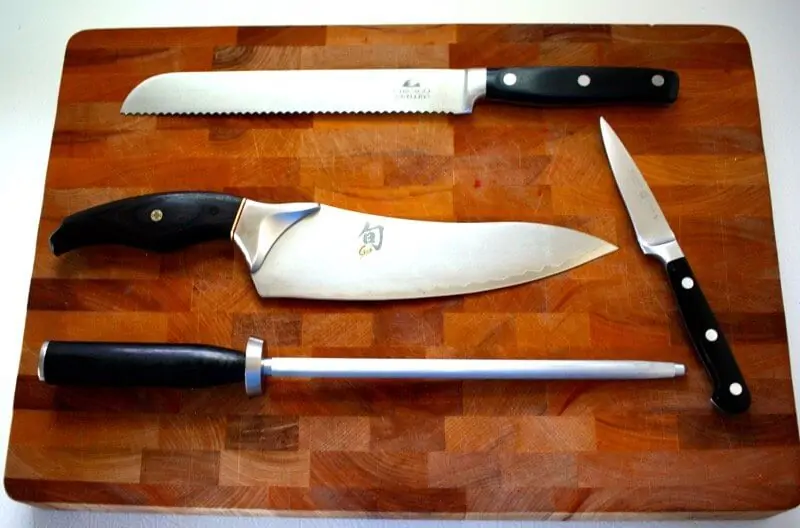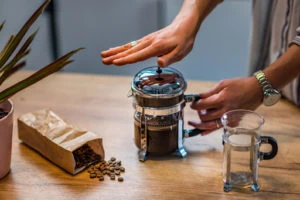
Looking for the best oil for cutting boards? Keep on reading, you’re in the right place.
Preparing your wooden cutting boards for use is a crucial step in your daily kitchen routine. The oils help slow the absorption of water and flavors of the foods that you cut on it, and prevent buildup of oils that will oxidize on your cutting board, turning it into a sticky, smelly mess.
My favorite oil is the Caren & Doucet Cutting Board and Butcher Block Oil from Amazon. It’s food grade, vegan, flame resistant, and gets the job done.
It also helps prevent swelling of the wood which can ultimately lead to your cutting board to warp and fall apart. If you are still learning about cutting boards, here is a list to get you started. Otherwise continue reading about a few of the popular choices for keeping your cutting boards in tip-top shape.
| Best Oil for Cutting Boards | Why We Like It |
|---|---|
| 1. John Boos Cutting Board Oil and Cream Set | includes oil to penetrate the wood board and cream to seal the surface itself using food-safe ingredients |
| 2. Caren & Doucet Cutting Board and Butcher Block Oil | oil is nontoxic, food-safe, vegan, and dye-, odor-, and color-free |
| 3. Walrus Oil Cutting Board and Butcher Block Oil | oil is FDA-certified made in USA, and has easy-to-use applicator and squeeze bottle |
| 4. Bull Hide Wood Oil | oil is all-natural food grade and waxes the board, keeping it strong |
| 5. Nature's Way Extra Virgin Coconut Oil | oil is non-GMO certified, free of dyes and additives, and is all-natural |
| 6. Earth Natural Botanical 100% Organic Beeswax | wax is healthy, safe, natural, smells great, and doesn't add any taste to food |
Commercially available cutting board cream/oil
These creams are typically a mixture of oils and waxes that are typically proven to protect your cutting board. They are created to help keep your cutting board in tip-top shape without much thought. However, because these oils are a mixture of a wide variety of oils, if you have a preference in what kind of oil you use in your cooking you might want to stay away from this option.
John Boos Cutting Board Oil and Cream Set
This is one of the most popular out there, and would be a great fit for almost any cutting board or someone looking for a straightforward care routine for their cutting board. It contains two products – one bottle of oil to penetrate deep into the wood surface and rehydrate, and a cream to seal the surface of the board itself. Both are NSF certified with food safe ingredients, and it gets great reviews for its easy-to-use regimen. Just oil up the board after washing, and then seal with the cream. Simple as that!
This is the GOOD Stuff. It’s a tad pricey but works well.
Mineral Oil
Mineral oil, also sometimes called liquid paraffin, can be a great conditioner for your cutting board. It’s a non-drying oil, and will not cause your board to get that plastic-y coating that you get when you season a pan.
It’s a great choice if you’re looking for that nice cutting surface that doesn’t cause water to bead off of it and still maintain that natural wood surface without the buildup of grime. Please note that in order to meet food standards, you need to get food grade mineral oil. This oil is created in a way that makes sure it’s use will not accidentally pollute the food on your cutting board.
Caren & Doucet Cutting Board and Butcher Block Oil
My favorite food grade mineral oil to use for my cutting boards is the oil from Caren & Doucet. It’s nontoxic and food safe, vegan, with no dyes, odors, or added colors. It’s also thicker, yet somehow more penetrating, than most other oils on the market. It beautifully and effectively refurbishes the wood on your cutting board.
It’s a non-drying oil, and will not cause your board to get that plastic-y coating that you get when you season a pan.
Walrus Oil Cutting Board and Butcher Block Oil
If you want an awesome food safe mineral oil for your cutting board, look no further than the mineral oil from Thirteen Chefs (I think they know what they’re talking about…). On top of being an FDA certified food grade oil, it’s also made here in the USA for quality and freshness assurance. It even has an easy-to-use push-to-operate applicator cap and squeezable bottle for the easiest oil application out there. This oil will penetrate wood, hydrate it, and prevent cracks while sealing the surface from any further damage. Great choice all around.
Bull Hide Wood Oil
This oil was made for this job. Created specifically for keeping wood nice and hydrated, and helping it last for years to come, this oil is made with all natural ingredients and it’s completely food grade. It’s primarily intended for waxing the board, keeping the surface tight and strong. It’s suitable for all types of wood, and it’s made in the USA to boot.
Or, check out Bull Hide’s Wood Oil. This is premium grade mineral oil.
Linseed Oil
Linseed oil is synonymous with flax or flax seed oil, and it’s one of the most popular choices for a variety of woodworking projects. Professional woodworkers often use boiled linseed oil to help protect large wooden pieces.
Though boiled linseed oil is not great for your cutting boards, un-boiled, food grade linseed oil is a great option for protecting that cutting board. This is a drying oil, and will help create a food-safe, plastic like coating on your board, which will make your cutting board easy to maintain and protect it from future damage.
Coconut Oil
I eat this stuff! And you can put it on your cutting board too. Check the latest pricing at Amazon.
Coconut oil has been proven to have a variety of uses in recent history, from hair conditioner to face cleanser. Believe it or not, food grade coconut oil works great for keeping that cutting board in top cooking condition, and works great when mixed with my next favorite oil…
Nature’s Way Extra Virgin Coconut Oil
A great choice in terms of the best coconut oil you can order from the internet comes from Nature’s Way. It comes in a large tub, 32 ounces, of pure, organic, cold pressed oil that can be scooped out and used for just about anything! It’s also non GMO certified and free of any dyes or harmful additives.
Because it’s all natural, it may solidify (or melt) depending on the temperature of its environment. But be assured that it is safe to use in either form, and if it’s solid when you want to use it for your cutting board, it’ll melt down easily once you start to work with it.
Bee’s Wax
Bee’s wax can work wonders for keeping your cutting board in prime cutting shape. It’s considered a “dry” oil, and can create a nice sheen on your cutting board that repels water and makes for easier cleaning and less absorption of your foods smells and tastes. It’s also great when mixed with one of the other popular oils, as it can help thicken and create a more water repellent layer on your cutting board.
Earth Natural Botanical 100% Organic Beeswax
Looking for a healthy, safe material to oil up your cutting board with? Well with this product, you get all that plus a deliciously sweet aroma. Don’t worry though – it won’t affect the taste of anything you chop on the board after you use it.
This beeswax comes in a set of 4 1 oz. rectangles that are perfectly designed for oiling. They’re also food grade, GMO free, USDA certified organic, and free of any additives like coloring or preservatives. You’re getting the pure, raw, healthy oil with this purchase, so it’s a great option for your kitchen.
Making your own mix
There are many different options when choosing an oil to care for your cutting board, and the choices can be overwhelming. This discussion post really helped me figure out what oils to use and how to mix them. Often a mixture can provide a great coating that has multiple benefits for your board.
You might like this post where I take a look at the best butcher knives for the money.
So, now that you’ve got a few ideas for what you need to condition your cutting board, you need to know how.
Oiling Your Cutting Board
Before you start oiling your cutting boards, make sure they’re nice and clean. Usually hand washing with a sponge and warm, soapy water will do. Some people like to give their board a good scrub too. You can do this with a mixture of salt and lemon or lime to add extra antioxidants to your cleaning process. If you used your cutting board for raw meat, you can also give it a quick wipe down with some hydrogen peroxide to ensure it’s entirely disinfected.
It’s also incredibly important not to leave your wooden cutting board soaking in water, as this can lead to irreparable warping and cracks.
So after you’ve washed and thoroughly dried your cutting board, it’s time to oil it up! It’s a great idea to add this quick and easy step to your washing routine to maintain the integrity of the material of the board, and make it stronger and more durable for future uses.
All you need to do is apply the oil to a paper towel or soft, light dish cloth, and then spread the oil in a thin layer over the entire board. Then, leave the board out to let the oil sink in for at least a few hours (or ideally, overnight). If there’s excess oil on the board after this period of time (i.e. if it feels sticky, slippery, or oily), rub this off with a dry paper towel or cloth until your board feels like wood again. It’s good to go for the next use — and many more to come!
Finally…
Please note that there are some oils that are not suitable for conditioning your cutting board. These are oils that will begin to oxidize (or rot) on your board. Vegetable oil, lard, and the like are all oils that will oxidize and cause your board to smell or leave behind a sticky film on your board, making it hard to keep clean. In addition, you need to make sure that any oils you use on your cutting boards are 100% food safe. That way you can make sure that the surfaces you are preparing your food on will not accidentally make your friends/family/patrons sick.
Easiest way to get a uniform cut, every time? Use a mandoline slicer.
Concerned about water quality? Read this post on water filtrations systems for the whole house.
Happy cooking!










